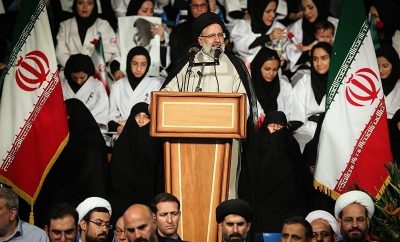Ebrahim Raisi, Iran’s President, Dies in Helicopter Crash Aged 63. “It Was Not Us” said Israeli Official “Who requested Anonymity”
Iranian president was travelling by helicopter in the country’s East Azerbaijan province when it came down in a forested area.

All Global Research articles can be read in 51 languages by activating the Translate Website button below the author’s name (only available in desktop version).
To receive Global Research’s Daily Newsletter (selected articles), click here.
Click the share button above to email/forward this article to your friends and colleagues. Follow us on Instagram and Twitter and subscribe to our Telegram Channel. Feel free to repost and share widely Global Research articles.
Global Research Wants to Hear From You!
Introduction
Israel has stated that they are not behind the death of President Raisi.
Israel on Monday denied involvement in the death of Iranian President Ebrahim Raisi in a helicopter crash that also killed several officials of his entourage.
“It wasn’t us,” news agency Reuters quoted an official, who requested anonymity.
For further details click here.
***
Iran’s President Ebrahim Raisi has died after a helicopter carrying him and other officials crashed in a mountainous and forested area of the country in poor weather.
The 63-year-old, a figure representing conservative and hardline factions in Iranian politics, was president for nearly three years, and appeared on track to run for re-election next year.
A former chief justice, Raisi was touted as a potential successor to Ayatollah Ali Khamenei, the 85-year-old supreme leader of Iran.
Raisi was born in Mashhad in northeastern Iran, a religious hub for Shia Muslims. He underwent religious education and was trained at the seminary in Qom, studying under prominent scholars, including Khamenei.
Also like the supreme leader, he wore a black turban, which signified that he was a sayyid – a descendant of the Prophet Muhammad, a status with particular significance among Twelver Shia Muslims.
Raisi racked up experience as a prosecutor in multiple jurisdictions before coming to Tehran in 1985. It was in the capital city that, according to human rights organisations, he was part of a committee of judges who oversaw executions of political prisoners.
The late president was a longtime member of the Assembly of Experts, the body that is tasked with choosing a replacement for the supreme leader in the event of his death.
He became attorney general in 2014 for two years, when he was appointed by Khamenei to lead the Astan Quds Razavi. The colossal bonyad, or charitable trust, has billions of dollars in assets and is the custodian of the shrine of Imam Reza, the eighth Shia imam.
Raisi initially ran for president in 2017, unsuccessfully challenging the re-election of former President Hassan Rouhani, who represented the centrist and moderate camps.
After a short hiatus, Raisi was making headlines as the new head of the Iranian judiciary system, having been appointed by Khamenei in 2019. He presented himself as a defender of justice and a fighter against corruption, and made many provincial travels to garner popular support.
Raisi became president in 2021 amid low voter turnout and wide disqualification of reformist and moderate candidates, and appeared to have secured a firm footing for re-election.
Like other top Iranian officials, his harshest rhetoric was reserved for Israel and the United States, followed by their Western allies.
Raisi made many speeches since the start of the war on Gaza in October to condemn “genocide” and “massacres” committed by Israel against Palestinians, and called on the international community to intervene.
He promised revenge against Israel after it levelled Tehran’s consulate building in Syria and killed seven members of the Islamic Revolutionary Guard Corps (IRGC), including two generals.
And he welcomed Iran’s response, which was to launch hundreds of drones and missiles at Israel, most of which were shot down by a coalition of Israeli allies – but left Iran claiming an overall success.
Raisi was hawkish on Iran’s 2015 nuclear deal with world powers, or the Joint Comprehensive Plan of Action (JCPOA), which has been in limbo after former US President Donald Trump unilaterally withdrew from it in 2018.
He was a champion of the strategic policy of “resistance” and “resilience” that Khamenei has adopted in the face of the harshest-ever sanctions that Iran has faced – imposed after the nuclear deal fell through.
A close ally of the IRGC, the late president was also a staunch backer of the “axis of resistance” of political and armed groups that Iran supports across the region, including in Iraq, Syria, Lebanon and Yemen.
And he was a strong backer of Syrian President Bashar al-Assad, who Iran has supported in his government’s war against the Syrian opposition, which has left hundreds of thousands dead.
Read the complete Al Jazeera article, click here
*
Note to readers: Please click the share button above. Follow us on Instagram and Twitter and subscribe to our Telegram Channel. Feel free to repost and share widely Global Research articles.
Featured image is licensed under CC BY 4.0

